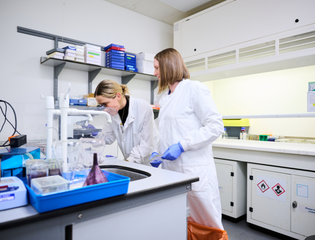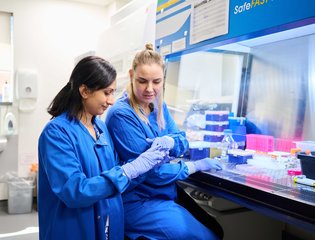BriTROC-2

Map of the UK
How the BriTROC-2 trial will aim to help create new, personalised treatments for women with ovarian cancer
BriTROC-2 is a new Ovarian Cancer Action funded study that will help towards our goal of finding better treatments that will help women to live longer. However, as well as benefiting women in the future, this collaborative effort will have benefits for women living with ovarian cancer now.
Lead researchers: Professor Iain McNeish and Professor James Brenton
Where: Glasgow Clinical Trials Unit, The Ovarian Cancer Action Research Centre and CRUK Cambridge Centre
Theme: Treatment
BriTROC-2 is a nationwide project to create new, personalised treatments for women diagnosed with High Grade Serous Ovarian Cancer (HGSOC). The team, co-led by Professor Iain McNeish and Dr James Brenton, know this next generation of tailored treatments will be just around the corner once we’ve learnt more about the disease.
The next generation of treatment
Personalised medicine is when treatment is customised and matched to the patient. Although HGSOC is one disease, two seemingly identical patients can respond well to different treatments. BriTROC-2’s goal is to give all HGSOC patients personalised care.
The original BriTROC project, led by the same team, discovered why this is: tiny genetic differences between ovarian cancer tumours can occur as cancer grows. And these differences explain why some cancers respond well, and others poorly, to certain treatments. Previously, these differences made ovarian cancer appear unpredictable and harder to treat. Now, Professor McNeish’s team can turn them to their advantage.
BriTROC scientists made this revelation while investigating how ovarian cancer changes over time. To do this, the project established a network of 14 research hubs around the UK to collect tissue samples from hundreds of relapsed cancer patients. This was a major step: it allowed BriTROC scientists to see patterns across more samples than ever before and meant other researchers now had the means to access and analyse these samples to make their own breakthroughs.
Seven clues for better treatment
BriTROC discovered that one of seven unique ‘signatures’ was being written into ovarian cancer’s DNA as it developed. Each signature, classified by a cluster of tiny genetic changes, offers a vital clue about how the patient should be treated.
Now, BriTROC-2 scientists are putting new samples under the microscope – to better understand these seven clues. By gathering information about the microscopic differences between cancers, underpinning a tumour’s response to treatment, doctors can move away from the ‘one-size-fits-all approach and give patients treatments that work.
Where are we now?
The majority of the centres across the UK taking part in the study have opened. They are on target for the number of patients recruited.


